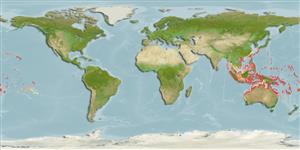Environment: milieu / climate zone / depth range / distribution range
Ecologia
marino associati a barriera corallina; distribuzione batimetrica 0 - 40 m (Ref. 128797). Tropical; 30°N - 30°S, 79°E - 130°W
Indo-Pacific: Sri Lanka (Ref. 10361) and Cocos-Keeling Islands to the Hawaiian, Marquesan and Tuamoto islands, north to southern Japan, south to Rowley Shoals and New South Wales, Australia.
Size / Peso / Age
Maturity: Lm ? range ? - ? cm
Max length : 30.0 cm TL maschio/sesso non determinato; (Ref. 559)
Spine dorsali (totale) : 12 - 14; Raggi dorsali molli (totale) : 21 - 25; Spine anali: 3; Raggi anali molli: 20 - 23.
Occur in lagoons and seaward reefs to a depth of 30 m, prefer coral-rich and clear water areas (Ref. 205). Benthopelagic (Ref. 58302). Encountered singly, in pairs or small groups (adults often in pairs; juveniles solitary and inshore). Feed on filamentous algae, small invertebrates, coral polyps, and fish eggs. Oviparous (Ref. 205). Form pairs during breeding (Ref. 205).
Life cycle and mating behavior
Maturities | Riproduzione | Spawnings | Egg(s) | Fecundities | Larve
Distinct pairing (Ref. 205). Monogamous mating is observed as both obligate and social (Ref. 52884).
Myers, R.F., 1991. Micronesian reef fishes. Second Ed. Coral Graphics, Barrigada, Guam. 298 p. (Ref. 1602)
IUCN Red List Status (Ref. 130435)
Human uses
Pesca: scarso interesse commerciale; Acquario: Commerciale
Strumenti
Special reports
Download XML
Fonti Internet
Estimates based on models
Preferred temperature (Ref.
123201): 25 - 29.3, mean 28.5 °C (based on 2323 cells).
Phylogenetic diversity index (Ref.
82804): PD
50 = 0.5000 [Uniqueness, from 0.5 = low to 2.0 = high].
Bayesian length-weight: a=0.02239 (0.01388 - 0.03612), b=3.02 (2.88 - 3.16), in cm total length, based on LWR estimates for this species & Genus-body shape (Ref.
93245).
Trophic level (Ref.
69278): 3.0 ±0.43 se; based on food items.
Resilienza (Ref.
120179): Alto, tempo minimo di raddoppiamento della popolazione meno di 15 mesi (Preliminary K or Fecundity.).
Fishing Vulnerability (Ref.
59153): Low vulnerability (20 of 100).
Nutrients (Ref.
124155): Calcium = 66.5 [35.2, 103.6] mg/100g; Iron = 0.669 [0.411, 1.043] mg/100g; Protein = 18.6 [17.5, 19.7] %; Omega3 = 0.104 [0.067, 0.158] g/100g; Selenium = 32.7 [19.3, 58.7] μg/100g; VitaminA = 43 [13, 139] μg/100g; Zinc = 1.21 [0.84, 1.72] mg/100g (wet weight);
